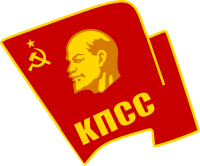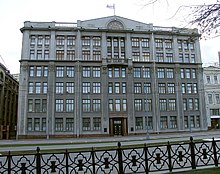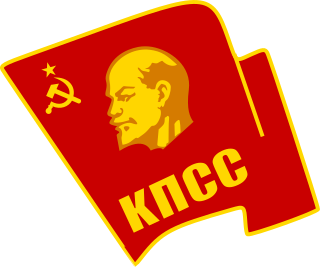
The Communist Party of the Soviet Union (CPSU), at some points known as the Russian Communist Party, All-Union Communist Party and Bolshevik Party, and sometimes referred to as the Soviet Communist Party (SCP), was the founding and ruling political party of the Soviet Union. The CPSU was the sole governing party of the Soviet Union until 1990 when the Congress of People's Deputies modified Article 6 of the 1977 Soviet Constitution, which had previously granted the CPSU a monopoly over the political system. The party's main ideology was Marxism-Leninism.
The organization of the Communist Party of the Soviet Union was based on the principles of democratic centralism.
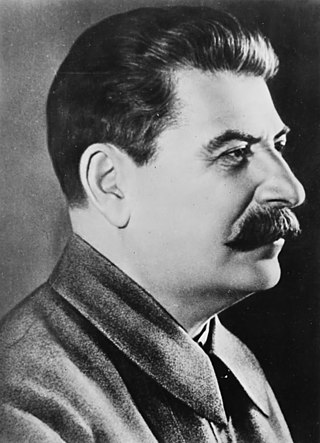
The General Secretary of the Central Committee of the Communist Party of the Soviet Union was the leader of the Communist Party of the Soviet Union (CPSU). From 1924 until the country's dissolution in 1991, the officeholder was the recognized leader of the Soviet Union. Prior to Stalin’s accession, the position was not viewed as an important role in Lenin’s government and previous occupants had been responsible for technical rather than political decisions.

Yakov Mikhailovich Sverdlov was a Bolshevik Party administrator and chairman of the All-Russian Central Executive Committee from 1917 to 1919. He is sometimes regarded as the first head of state of the Soviet Union, although it was not established until 1922, three years after his death.
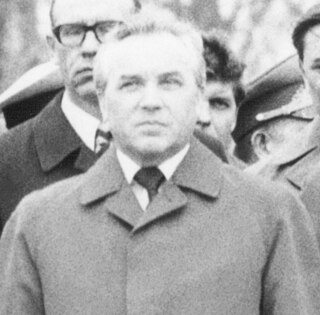
Grigory Vasilyevich Romanov was a Soviet politician and member of the Politburo and Secretariat of the Communist Party of the Soviet Union. In 1985, he was considered Mikhail Gorbachev's main rival in the succession struggle after the death of Konstantin Chernenko in March 1985, the third Soviet leader to die in just a few short years.

Jānis Rudzutaks was a Latvian Bolshevik revolutionary and a Soviet politician. He was executed during the Great Purge.
The history of the Communist Party of the Soviet Union was generally perceived as covering that of the Bolshevik faction of the Russian Social Democratic Labour Party from which it evolved. In 1912, the party formally split, and the predecessor to the Communist Party of the Soviet Union became a distinct entity. Its history since then can roughly be divided into the following periods:
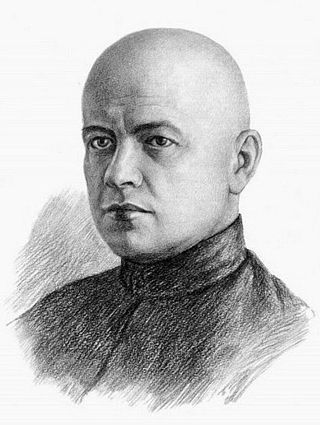
Stanisław Vikentyevich Kosior, sometimes spelled Kossior, was a Soviet politician who was First Secretary of the Communist Party of Ukraine, Deputy Premier of the Soviet Union and member of the Politburo of the Communist Party of the Soviet Union (CPSU). He and his wife were both executed during the Great Purge.
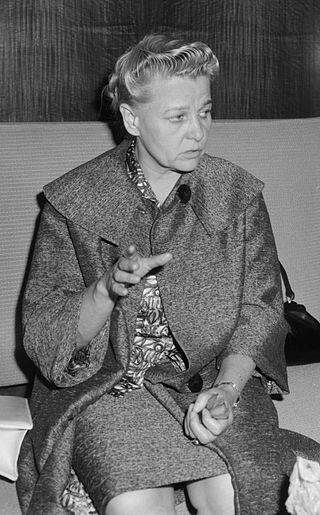
Yekaterina Alexeyevna Furtseva was a Soviet politician and member of the Communist Party of the Soviet Union (CPSU). She was the second woman to be elected member of the CPSU Presidium and the fourth woman elected to the CPSU Secretariat. The first female Politburo and Secretariat member was Yelena Stasova.

Andrey Andreyevich Andreyev was a Soviet Communist politician. An Old Bolshevik who rose to power during the rule of Joseph Stalin, joining the Politburo as a candidate member in 1926 and as a full member in 1932, Andreyev also headed the powerful Central Control Commission of the Communist Party of the Soviet Union from 1930 to 1931, and then again from 1939 until 1952.
Boris Georgiyevich Bazhanov was a Soviet secretary of the Secretariat of the Communist Party of the Soviet Union who defected from the Soviet Union on 1 January 1928.
The 8th Congress of the Russian Communist Party (b) was held in Moscow 18–-23 March 1919. The Congress was attended by 301 voting delegates who represented 313,766 Party members. A further 102 delegates attended with speaking rights, but no vote. It elected the 8th Central Committee.

Alexander Nikolaevich Poskrebyshev was a Soviet politician and a state and Communist Party functionary. A member of the Communist Party of the Soviet Union since March 1917, he was chief of the special department of the Central Committee of the Communist Party.

Elena Dmitriyevna Stasova was a Russian Soviet revolutionary, Old Bolshevik and an early leader of the organisation that would go on to become the Communist Party of the Soviet Union.

The Political Bureau of the Central Committee of the Communist Party of the Soviet Union, or Politburo was the highest political body of the Central Committee of the Communist Party of the Soviet Union and defacto a collective presidency of the USSR. It was founded in October 1917, and refounded in March 1919, at the 8th Congress of the Bolshevik Party. It was known as the Presidium from 1952 to 1966. The existence of the Politburo ended in 1991 upon the breakup of the Soviet Union.

The Central Committee of the Communist Party of the Soviet Union was the highest organ of the Communist Party of the Soviet Union between two congresses. According to party statutes, the committee directed all party and governmental activities. The Party Congress elected its members.

The Orgburo, also known as the Organisational Bureau, of the Central Committee of the Communist Party of the Soviet Union existed from 1919 to 1952, when it was abolished at the 19th Congress of the Communist Party and its functions were transferred to the enlarged Secretariat.

The Central Committee (CC) composition was elected by the 10th Congress, and sat from 16 March 1921 until 2 April 1922. The CC 1st Plenary Session renewed the composition of the Politburo, Secretariat and the Organizational Bureau (OB) of the Russian Communist Party (Bolsheviks).

The Central Committee (CC) composition was elected by the 11th Congress, and sat from 2 April 1922 until 25 April 1923 . The CC 1st Plenary Session renewed the composition of the Politburo, Secretariat and the Organizational Bureau (OB) of the Russian Communist Party (Bolsheviks).
The Central Committee (CC) composition was elected by the 16th Congress, and sat from 13 July 1930 until 10 February 1934. Its 1st Plenary Session elected the Politburo, Secretariat and Orgburo. The 16th Congress was the first party convention since the 13th Congress which saw no organized opposition, and the first congress in party history in which there was no opposition to the party leadership. Ukrainian historian Oleg Khlevniuk considers the period 1930–1934 to be a "transitional period" between collective leadership (referred to interchangeably by him as oligarchy) and Joseph Stalin's personal dictatorship (autocracy). The removal of Alexei Rykov, the Chairman of the Council of People's Commissars (SNK, the Soviet government), from the Politburo at the 1st Joint Plenary Session of the CC and the Central Control Commission (CCC) has been marked in historic literature as "the definitive Stalinization of that body [Politburo]" according to Khlevniuk.
